As we approach the fall and the beginning of the traditional snowbird migration, I have been thinking a lot about what the Caribbean winter cruising season will look like as we face a second winter season of pandemic. I have been in touch with some of my contacts in Antigua with the hope of better understanding what a visit to Antigua and the islands of the Leeward and Windward islands will look like this winter.
While the details remain fuzzy, it is clear that Antigua, and other islands are anxious to return to some sort of normalcy, given the outsize importance of tourism to their economies. For many islands, tourism represents upwards of 80% of their economy and for them to miss next season will have a devastating effect on their economy.
As of now, anyone visiting Antigua will have to show proof of a negative Covid test taken within 72 hours of departure and be compelled to have a rapid test on arrival if they are showing any symptoms of illness, Covid or not. And, in many cases, they will still be subject to quarantine after arrival. I guess that means staying on premises at a resort for the duration of your time on the island, assuming that you aren’t going to be there for more than 14 days.
As far as group events are concerned, they are limited to a total of 25 attendees which surely suggests that the Classic Yacht Regatta and Sailing Week will both have to be canceled unless things improve by April. There is a long time between now and next spring but we will just have to wait and see how things develop. Given what’s going on in the US with our out of control response to the virus, I am not optimistic about how the season will develop for us.
However, with regards to Antigua and arrival in private yachts, the same will apply as with airline based arrivals but I understand that credit toward quarantine time will be given for days at sea. Additionally, there is a widely held belief that the yachting segment will rebound faster than short term visits.
I guess that we will have to wait and see how things develop as the season wears on and see if outbreaks occur, which they likely will, on various islands, likley leading to additional restrictions. My greatest concern is wondering what air travel will be like by spring when crew is trying to head to Antigua to help bring back boats from a winter of cruising. It would be terrible if we again faced the difficulty in getting home. I don’t expect that many cruisers will be happy to face the prospect of returning to the US under such difficult circumstances for a second year in a row, certainly not Brenda.
Again this week, the Bahamas issued revised rules for visitors that were a dramatic change from their guidance of only one week ago. Most recently, visitors from the US were not allowed in the country at all and now, just one week later, that’s been changed to say that visitors from the US can come, along with everyone else but all will be subject to the same mandatory 14 day quarantine. In the event that someone tests positive at the airport, or are showing signs of illness, they will be put into mandatory quarantine in a government facility for the duration of their illness. If you don’t show symptoms, visitors who are on a short stay of less than 14 days, can serve their time in quarantine at the resort where they are staying, provided that they don’t leave the grounds.
Additionally, at the end of a visit, if it is less than two weeks, departing visitors must submit to a second Covid test to confirm that they are still well and have not exposed anyone to the virus. All of this makes sense as these islands have very little infrastructure to address a major disease outbreak so they must be especially diligent in keeping the disease out of their country.
As I write this, we have just departed St Michaels MD, aboard Pandora with my longtime cruising buddy Craig. It’s really hot, in the mid 90s, and unlike the Caribbean, the breeze dies completely at night which makes for really oppressive heat and humidity. While I recently upgraded my AC, I still don’t have a large enough generator to handle the load when at anchor so it’s tough to be “off the grid” in the evening when the wind goes still.
I’ll admit that at my tender age as a newly diagnosed “senior” I am a lot less tolerant of the heat, been-there-done-that, so being comfortable is my preference. While it’s not much hotter here than in the Caribbean, the humidity seems worse and the lack of a breeze at night makes sleeping conditions much more uncomfortable than we have experienced in the Caribbean where there is always a breeze.
With all of this in mind, Craig and I decided that we’d spring for some time on the dock and booked a few nights at one of the marinas. The rates from marina to marina vary a lot but we found one that wasn’t bad at $1.75/ft, during the week.
Originally, we had planned to anchor out and swim if it was too hot. However, the jelly fish that the Chesapeake is famous for, Sea Nettles, are out in force and I am told that keeps most folks out of the water in the heat of the summer. This specimen, one of thousands in the waters around us, was about 18″ long and packs an unpleasant sting if you are unlucky enough to tangle with one. I went in for a brief swim but had to abandon after only a brief dip as the “herd” closed in.  When we were tied up in the marina, AC blasting, the whole system abruptly shut down when one jelly was sucked into my strainer and filled it with goo. I’d expect that was one unhappy jelly. Of course, that’s if jellies can be happy or sad. I cleaned out the goo and and was able to restart both units.
When we were tied up in the marina, AC blasting, the whole system abruptly shut down when one jelly was sucked into my strainer and filled it with goo. I’d expect that was one unhappy jelly. Of course, that’s if jellies can be happy or sad. I cleaned out the goo and and was able to restart both units.
High season or not, I was shocked by how empty the marina was. We were the only transient boat there for our two nights. In spite of the empty marina, I had heard anecdotally, that boating is booming right now, with boats selling fast and the used boat market showing signs of significant growth after years of stagnation. All of this does make sense given that being aboard a boat is naturally a pastime that offers good “social distancing”.
In spite of the empty marina, I had heard anecdotally, that boating is booming right now, with boats selling fast and the used boat market showing signs of significant growth after years of stagnation. All of this does make sense given that being aboard a boat is naturally a pastime that offers good “social distancing”.
Even the anchorages near the harbor were empty with only a single boat anchored outside.  The Chesapeake Bay Museum, a large facility, is vacant too, with only two boats tied up at their docks.
The Chesapeake Bay Museum, a large facility, is vacant too, with only two boats tied up at their docks. 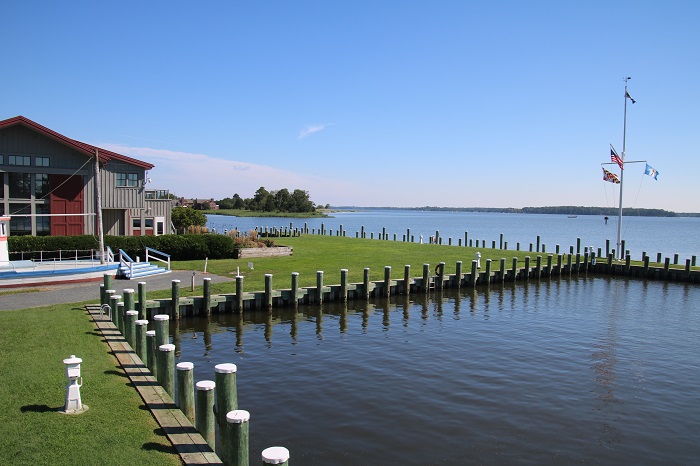 There is a tiny inlet behind the museum where Brenda and I have anchored in the past. Vacant, save a single visiting boat.
There is a tiny inlet behind the museum where Brenda and I have anchored in the past. Vacant, save a single visiting boat. 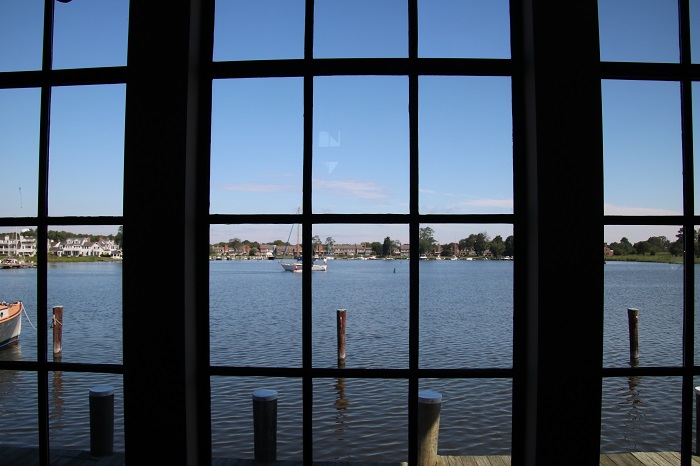 Craig and I toured the museum, it too largely empty, and saw a lovely exhibit of Rosenfeld prints. This view of a crowded ladies day gathering at Larchmont Yacht Club in 1911 seems so quaint given all the restrictions about group gatherings these days.
Craig and I toured the museum, it too largely empty, and saw a lovely exhibit of Rosenfeld prints. This view of a crowded ladies day gathering at Larchmont Yacht Club in 1911 seems so quaint given all the restrictions about group gatherings these days. 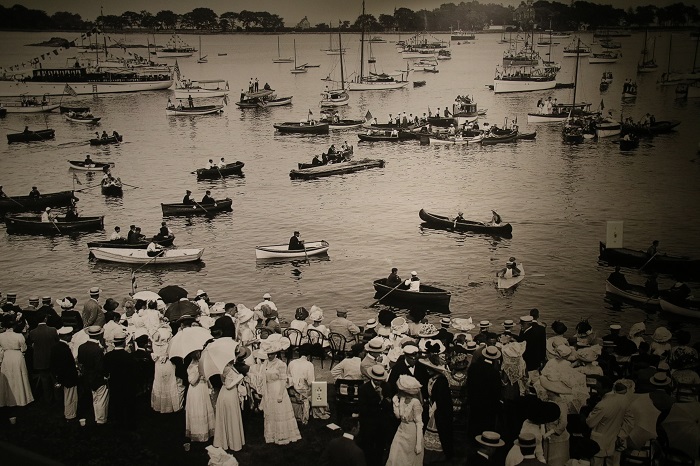 We walked along Main Street and it wasn’t very hard to get a shot of the stores without the view of a single car passing by.
We walked along Main Street and it wasn’t very hard to get a shot of the stores without the view of a single car passing by.  It’s hard to imagine that we were here during high season with the place to ourselves. Sure, there were others on the grounds but we were never anywhere with more than two or three visitors, all wearing masks when they got close.
It’s hard to imagine that we were here during high season with the place to ourselves. Sure, there were others on the grounds but we were never anywhere with more than two or three visitors, all wearing masks when they got close.  The collection of working boats at the museum seem well cared for and it’s a fairly large collection including several ketch or sloop rigged oyster boats. This push boat was all muscle and little boat. The engine used to push the “mother ship” around when the winds are light.
The collection of working boats at the museum seem well cared for and it’s a fairly large collection including several ketch or sloop rigged oyster boats. This push boat was all muscle and little boat. The engine used to push the “mother ship” around when the winds are light.  This “buy boat” that would have gone from boat to boat to buy their catch and take it to market, has charming lines.
This “buy boat” that would have gone from boat to boat to buy their catch and take it to market, has charming lines.  You can tell from the low freeboard on this boat that the waters she fished were well sheltered.
You can tell from the low freeboard on this boat that the waters she fished were well sheltered. This working boat was designed to run crab lines, long and narrow as it could be counted on to track easily on straight runs as they ran down long raising crab lines with baits along the bottom that were left in place or “soaked” for an hour or two. After a while the boat would head back down the string, pulling each bait up toward the surface so that the fisherman could use a dip net to catch the crab before it reached the surface of the water and dropped off.
This working boat was designed to run crab lines, long and narrow as it could be counted on to track easily on straight runs as they ran down long raising crab lines with baits along the bottom that were left in place or “soaked” for an hour or two. After a while the boat would head back down the string, pulling each bait up toward the surface so that the fisherman could use a dip net to catch the crab before it reached the surface of the water and dropped off.  The museum is building a replica of the Dove, the first ship to brought settlers to Maryland in the 1600s and a replacement for a prior reproduction built in 1978. The project is expected to take two years to complete. I expect that is an optimistic goal given the pandemic. She is a sweet little ship.
The museum is building a replica of the Dove, the first ship to brought settlers to Maryland in the 1600s and a replacement for a prior reproduction built in 1978. The project is expected to take two years to complete. I expect that is an optimistic goal given the pandemic. She is a sweet little ship. 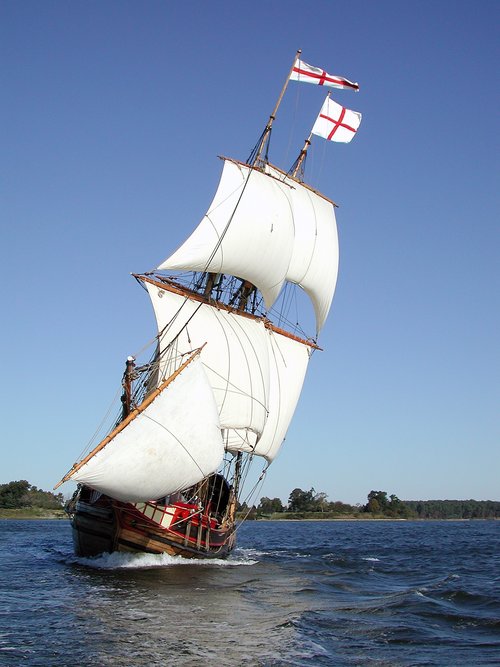 Her replacement has a long way to go, in frame now.
Her replacement has a long way to go, in frame now.  As we headed out from St Michaels today, it was nearly dead calm and in our wake, a charming view of the city.
As we headed out from St Michaels today, it was nearly dead calm and in our wake, a charming view of the city.  We passed a fleet of young sailors out for classes on the water, part of a summer sailing program. They were adorable, sailing in formation in their little prams.
We passed a fleet of young sailors out for classes on the water, part of a summer sailing program. They were adorable, sailing in formation in their little prams. 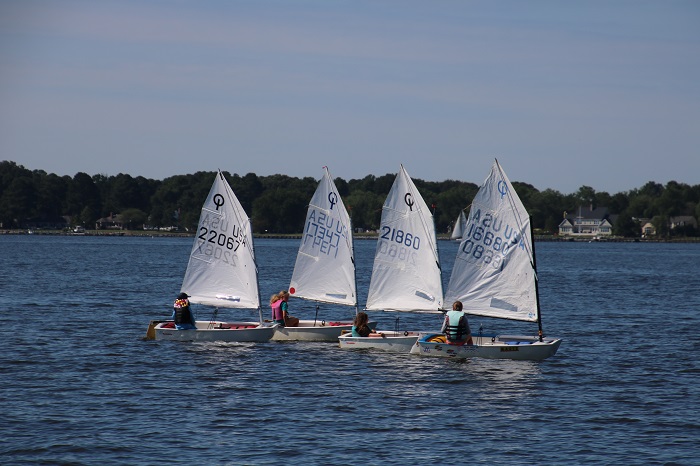 Cruising in the age of pandemic, whether in the Caribbean or here in the US is very different than what we have grown up with but hopefully we will soon be looking back on this as a distant memory and looking forward to many more years of carefree time on the water.
Cruising in the age of pandemic, whether in the Caribbean or here in the US is very different than what we have grown up with but hopefully we will soon be looking back on this as a distant memory and looking forward to many more years of carefree time on the water.
For now, north or south, we are all adjusting to new normal and the realities of cruising in the age of pandemic. Let’s hope that things head back toward normal again soon, whatever normal ends up looking like.

One response to “Cruising in an age of pandemic”